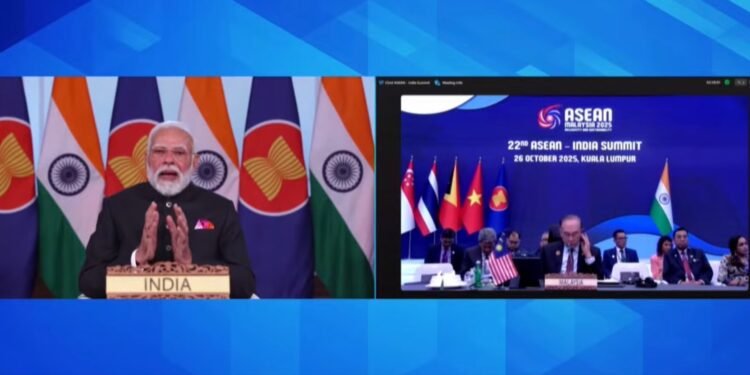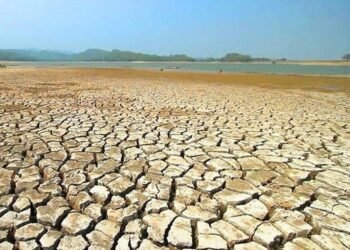Prime Minister Narendra Modi’s virtual appearance at the 22nd ASEAN–India Summit on 26 October 2025 was, by design, modest in rhetoric and consequential in signals. Against the immediate backdrop of ASEAN’s first enlargement since the 1990s, Timor-Leste’s accession to the bloc during the Kuala Lumpur meetings, the address underlined India’s preference for incremental, instrument-driven engagement over headline-grabbing alignments.
But modesty in tone should not be mistaken for lack of purpose. The announcements and subtler diplomatic choices outlined a strategy for preserving options in a region where strategic friction, economic contestation, and humanitarian crises now coexist.
Timor-Leste’s accession was the most striking contextual development surrounding the summit. The island’s formal entry as ASEAN’s 11th member heralded across international outlets and confirmed at the summit, carries both symbolic and practical consequences: ASEAN projects inclusivity at a time of heightened external pressure, and small-state diplomacy gains renewed relevance. New Delhi’s public welcome and pledge of development support to Timor-Leste fit a longer Indian pattern of engaging smaller Southeast Asian states as partners of capacity building rather than clients of big-ticket infrastructure agendas. That posture preserves India’s diplomatic flexibility but also limits its ability to counterbalance much larger external footprints.

Modi’s substantive proposals were concentrated and instrumentally oriented. The Prime Minister urged an early legal and commercial review of the ASEAN–India Trade in Goods Agreement (AITIGA), designated 2026 as the “ASEAN-India Year of Maritime Cooperation,” proposed a second round of ASEAN–India defence and maritime exercises, and announced a set of development-facing initiatives, renewable energy training, Quick Impact Projects for Timor-Leste, and a proposed Centre for Southeast Asian Studies at Nalanda University. These measures, set out in the PMO readout and reported widely in Indian media, reflect a pragmatic mix: economic re-engagement, maritime cooperation, and soft-power investments.
Taken together, these steps reveal two linked calculations. First, New Delhi recognises the material stakes in economics and maritime affairs: supply-chain resilience, semiconductors, critical minerals, and fisheries are not abstract priorities but core interests that feed domestic industrial strategies.
Modi’s call to revisit AITIGA is a response to those pressures; government reporting and contemporaneous coverage make clear that India seeks a modernised quid pro quo market access improvements for Indian exporters and clearer rules on non-tariff measures for both sides. A substantive AITIGA revision would be consequential if it addresses regulatory convergence in digital trade, investment protections, and critical-sector cooperation, but precedent tempers expectations: trade reviews often stall without strong domestic political buy-in and reciprocal concessions.
Second, the maritime framing is less about direct confrontation and more about capability building and norms. Declaring a maritime cooperation year and proposing more exercises signals India’s intent to deepen interoperability with ASEAN partners on domain awareness, HADR, and fisheries protection areas where ASEAN states seek practical cooperation and where overt military posturing would trigger domestic political sensitivities.
Yet the operational impact will depend on ASEAN coherence and appetites for security engagement; internal ASEAN divisions—exacerbated by differing threat perceptions of China—limit how far New Delhi can scale these initiatives.
Those divisions matter because the broader strategic environment is deteriorating. The South China Sea witnessed renewed incidents in October 2025, confrontations between Chinese vessels and Philippine coastguard or fisheries boats were publicly condemned by external powers and Beijing’s pattern of assertive patrols has remained a regional flashpoint.
Separately, the U.S.–China relationship has entered a fraught phase of trade coercion and supply-chain contestation, with high-stakes measures around rare earths and tariffs reverberating across Asia’s industrial plans. These developments elevate the importance of mid-sized powers like India and ASEAN states to provide risk-mitigation and pragmatic cooperation—yet they also complicate the room for manoeuvre those actors enjoy.
Meanwhile, the humanitarian and governance crisis in Myanmar continues to shadow Southeast Asia: food insecurity, displacement, and constrained humanitarian access have deepened, and ASEAN’s own mechanisms have struggled to produce durable relief or political progress.
Myanmar remains a litmus test of ASEAN’s capacity to act collectively; India’s offer to play a regional responder in HADR and disaster preparedness is relevant here, but New Delhi lacks the leverage or the mandate to substitute for a unified ASEAN approach. Unless ASEAN overcomes internal deadlock on Myanmar, security and normative leadership in the neighbourhood will remain fragmented.
If the summit marked India’s calibrated integration into ASEAN’s agendas, it also exposed limits. India’s developmental diplomacy, training programmes, QIPs, university initiatives strengthens long-term ties, but it is incremental relative to the scale of Chinese economic statecraft or the immediacy of U.S. security guarantees.
Moreover, ambitious declarations such as a Nalanda centre or a large-scale maritime festival at Lothal will require consistent bureaucratic follow-through and funding allocations; without those, such announcements risk remaining politically useful yet operationally hollow.
For policymakers and analysts, the takeaway is twofold. First, New Delhi’s ASEAN strategy is intentionally hedged: it prioritises practical cooperation, capacity building, and norm consolidation over forceful alignment. That approach reduces the risk of forcing ASEAN states into binary choices, preserving India’s access across a contested region.
Second, hedging alone is insufficient. To be a meaningful stabiliser, India must translate summit pledges into measurable outcomes speeding trade negotiations with concrete regulatory fixes, investing in maritime surveillance partnerships that produce shared datasets and joint training, and providing predictable development assistance to small states like Timor-Leste to build institutional resilience.
The 22nd ASEAN–India Summit was not a moment of rupture or dramatic reorientation. It was, instead, a test of execution. In a fractured Indo-Pacific, the region needs partners that can deliver, not merely reassure. India’s challenge is to convert calibrated diplomacy into operational reliability, at a tempo and scale that matters to its ASEAN partners. Until that happens, India’s role will remain that of a credible interlocutor with constrained influence: important, but not decisive.
–Dr. Shahid Siddiqui | Follow on X @shahidsiddiqui
WATCH GLOBAL NEWS and EXCLUSIVE TALKS





















